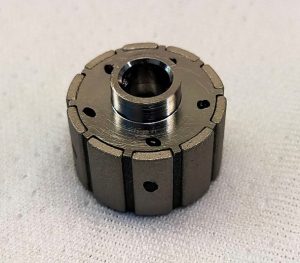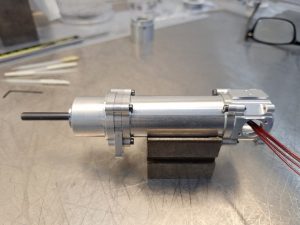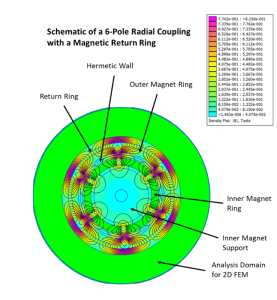ESR Space is happy to share that a new contract has been initiated with ESA to develop innovative drive components. The goal of the project is to rapidly develop new torque couplings to be useful over a wide range of systems, regardless of the size required. Lunar systems will often require operation in harsh environments characterised by extreme temperatures and dust. This will enable quicker adaptation of existing technologies for use on landers, rovers, in experiments and for ISRU applications (in-situ resource utilization). It also provides an over-torque protection mechanism which lets the drive slip to protect the motor from damage in extreme load cases.


Breadboard Magnetic Coupling Rotor Assembly (left) and Coupling assembled onto a Stepper Motor/Gearbox assembly (right), which were developed for the Lunar Thermal Shutter and will be used as a reference point for scaling of detailed magnetic models covering more than 2 orders of magnitude.
As of 06-Aug-2024, ESR has entered into a contract with ESA for Early Technology Development under the OSIP programme entitled, “Scalable Magnetic Couplings: Feasibility Study for Sealed Motor Drive Elements with Overdrive Protection for Operation in Extreme Environments.”
Work has been done previously on magnetic couplings for space, which has allowed for separation of the motor from the load, where it is sometimes beneficial for cleanliness. Under the OSIP study, the planned innovation comes with new mitigation strategies to handle dusty conditions, and allows for operation down to -150°C. Lunar dust can be incredibly abrasive and involve a huge range of particle sizes. This torque coupling development will save on costs to requalify actuators, allowing for previously qualified motor and gear elements to be completely sealed. This means that these elements will likely not need further component-level qualification to be used in such challenging environments (Moon, Mars or other bodies).

The coupling connects to the output magnetically through a thin metallic wall and has much wider air gaps than normal motors, so it can tolerate contamination by dust to a greater degree. The susceptibility to dust can be tailored to specific applications by adding lightly loaded sliding seals (managing added drive torque) to allow for operation in the harshest conditions if necessary.
This concept has been tested in another ESA development contract, as a key drive component of a Lunar Thermal Shutter development (referred to as LDRLR = Lunar Dust Resilient Louvered Radiator) that is targeting applications related to the EL3/Argonaut programme. This programme has recently reached TRL 4 and is highlighted in a datasheet here and in recent papers presented at AMS and ICES.
Andrew Gibson, Head of Mechanisms emphasised that “this project gives ESR the opportunity to expand on our experience developed during the Lunar Shutter Development. We will be enabled to rapidly develop useful drive components to drive a range of loads, from tiny port cover mechanisms to medium-sized rovers, where it should enable a lot of risk mitigation for the upcoming decade of lunar projects. It will also continue to build our experience in sliding seals and dust mitigation methods which will be crucial to so many upcoming challenges for the Moon and beyond.”
The Open Space Innovation Platform (OSIP) was launched by ESA to better serve the emerging needs of the modern space sector. The platform is now the main entry point for novel ideas into ESA, both in response to specific problems and through open calls for ideas.
For any further information or enquiries into space mechanisms, contact us via info@esrtechnology.com.